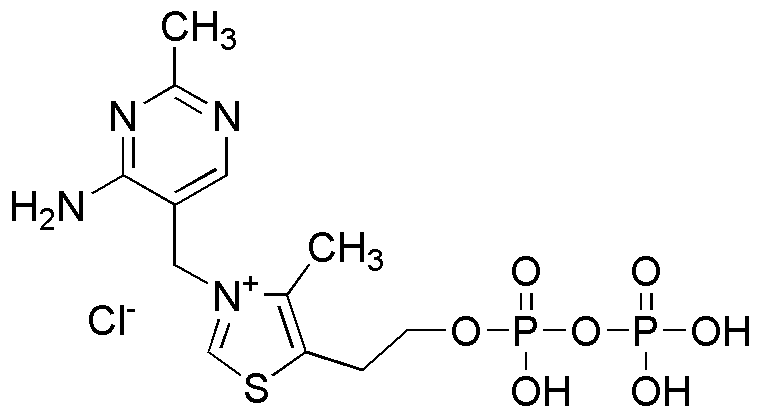Thiamine pyrophosphate is widely utilized in research focused on:
- Enzyme Cofactor: It serves as a crucial cofactor for several enzymes involved in carbohydrate metabolism, making it essential in studies related to energy production and metabolic pathways.
- Neuroscience Research: This compound plays a significant role in neurotransmitter synthesis, particularly in studies investigating cognitive functions and neurodegenerative diseases.
- Food Industry: Thiamine pyrophosphate is used as a food additive to fortify products, enhancing nutritional value and preventing deficiencies in populations at risk.
- Pharmaceutical Development: It is explored in drug formulations aimed at treating metabolic disorders, providing therapeutic benefits by restoring normal metabolic functions.
- Plant Biology: The compound is utilized in agricultural research to study its effects on plant growth and development, particularly in enhancing crop yields through improved nutrient utilization.
General Information
Properties
Safety and Regulations
Applications
Thiamine pyrophosphate is widely utilized in research focused on:
- Enzyme Cofactor: It serves as a crucial cofactor for several enzymes involved in carbohydrate metabolism, making it essential in studies related to energy production and metabolic pathways.
- Neuroscience Research: This compound plays a significant role in neurotransmitter synthesis, particularly in studies investigating cognitive functions and neurodegenerative diseases.
- Food Industry: Thiamine pyrophosphate is used as a food additive to fortify products, enhancing nutritional value and preventing deficiencies in populations at risk.
- Pharmaceutical Development: It is explored in drug formulations aimed at treating metabolic disorders, providing therapeutic benefits by restoring normal metabolic functions.
- Plant Biology: The compound is utilized in agricultural research to study its effects on plant growth and development, particularly in enhancing crop yields through improved nutrient utilization.
Documents
Safety Data Sheets (SDS)
The SDS provides comprehensive safety information on handling, storage, and disposal of the product.
Product Specification (PS)
The PS provides a comprehensive breakdown of the product’s properties, including chemical composition, physical state, purity, and storage requirements. It also details acceptable quality ranges and the product's intended applications.
Certificates of Analysis (COA)
Search for Certificates of Analysis (COA) by entering the products Lot Number. Lot and Batch Numbers can be found on a product’s label following the words ‘Lot’ or ‘Batch’.
*Catalog Number
*Lot Number
Certificates Of Origin (COO)
This COO confirms the country where the product was manufactured, and also details the materials and components used in it and whether it is derived from natural, synthetic, or other specific sources. This certificate may be required for customs, trade, and regulatory compliance.
*Catalog Number
*Lot Number
Safety Data Sheets (SDS)
The SDS provides comprehensive safety information on handling, storage, and disposal of the product.
DownloadProduct Specification (PS)
The PS provides a comprehensive breakdown of the product’s properties, including chemical composition, physical state, purity, and storage requirements. It also details acceptable quality ranges and the product's intended applications.
DownloadCertificates of Analysis (COA)
Search for Certificates of Analysis (COA) by entering the products Lot Number. Lot and Batch Numbers can be found on a product’s label following the words ‘Lot’ or ‘Batch’.
*Catalog Number
*Lot Number
Certificates Of Origin (COO)
This COO confirms the country where the product was manufactured, and also details the materials and components used in it and whether it is derived from natural, synthetic, or other specific sources. This certificate may be required for customs, trade, and regulatory compliance.


